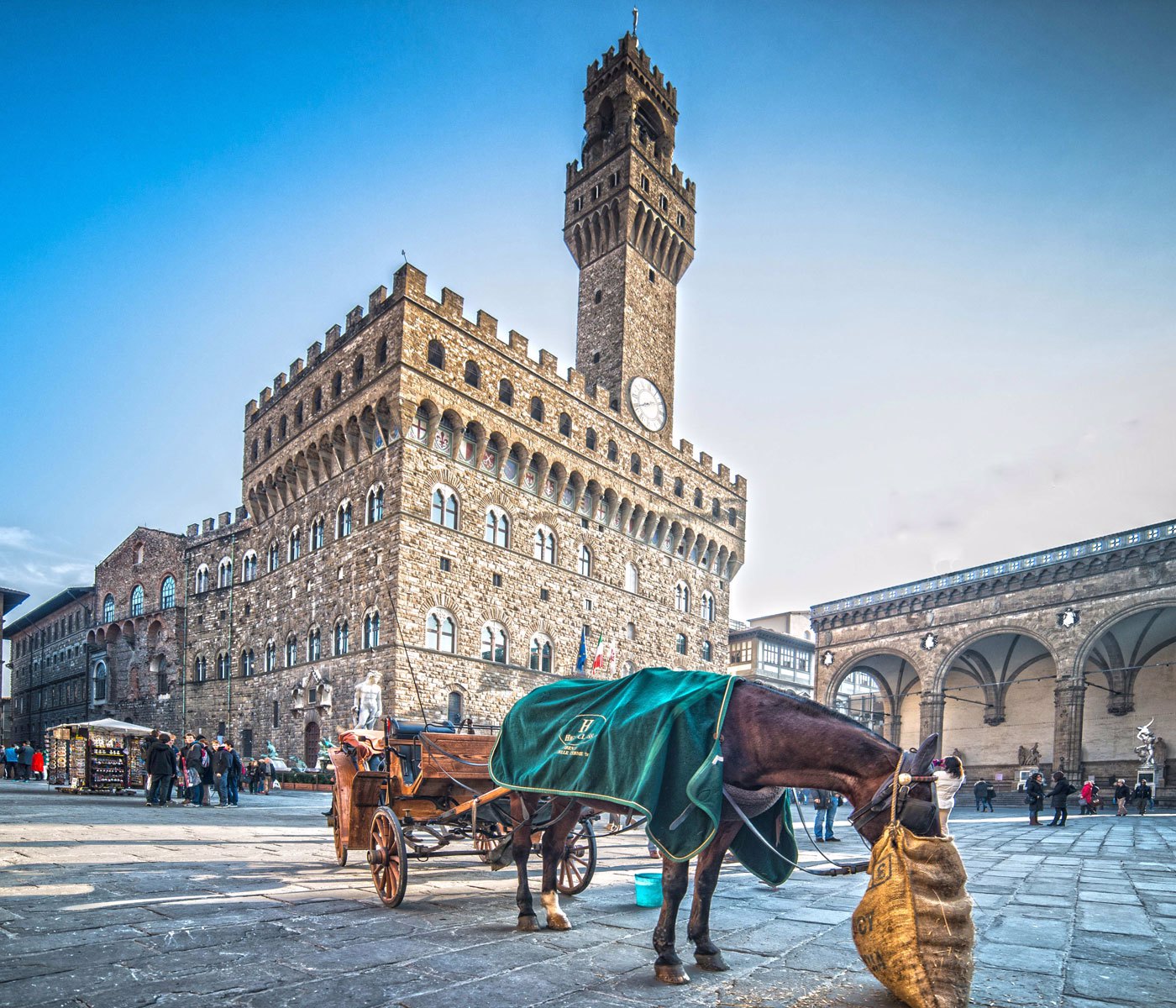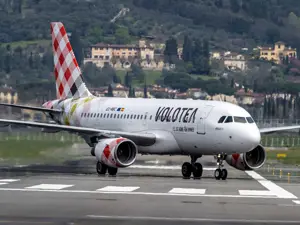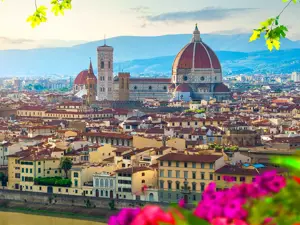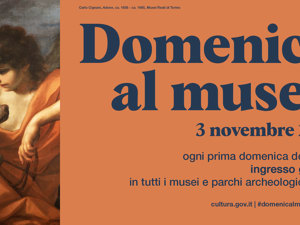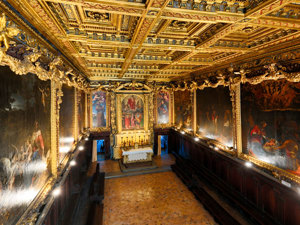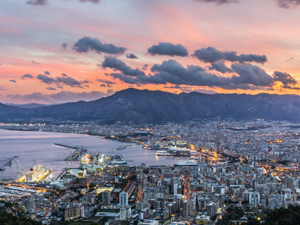The city of art and home of Dante Alighieri
There is no one in the world who wouldn’t like to visit Florence at least once in their life. This splendid Tuscan city is strongly marked by the presence of the Medici, the illustrious family who from the fifteen century, with their ‘hothouse’ of artists, contributed to making it splendid.
This ‘hothouse’ was also the training ground of others such as Filippo Brunelleschi, who designed the dome of the Duomo, a cathedral dedicated to St. Mary of the Flower. Brunelleschi’s dome has become a symbol of the chief town of Tuscany and is visible even from afar. Its impressive size, elegance and proportions, perfectly highlighted by white ribbing, still instil wonder in visitors today.
The beauty of Florence is due to its refined grace and a discreet charm that is expressed in the Ducal palaces, city residences and cobbled streets, which were built according to an organised urban layout.
Piazza del Duomo in Florence

Florence. Photo: Copyright © Sisterscom.com / Shutterstock
The heart of the city is the Piazza del Duomo where the Cathedral – one of the three largest in the world – is flanked by the very tall Campanile di Giotto (Giotto’s Bell Tower) and the geometric Baptistery dedicated to St. John the Baptist, patron saint of the city. The baptistery is embellished with bronze doors, the so-called Gates of Paradise, which were exquisitely sculpted by Lorenzo Ghiberti with bas-reliefs depicting episodes from the Old Testament.
Piazza della Signoria in Florence
Various roads filled with majestic buildings radiate off from the square. At the end of Via de’ Calzaioli (Shoemaker Street – many of the streets are named after the old guilds of the city) lies Piazza della Signoria, where the towering building of Palazzo Vecchio stands. The first residence and symbol of the political power of the Medici, the rooms of this building, where members of this renowned family lived, can be visited today. Each year, on 24th June, a historic ‘costumed football’ match takes place in the square, with the participation of over 530 characters and flag-wavers dressed in Renaissance costume.
Nearby stands the oldest art gallery in the world, the Uffizi, - the work of Vasari - where works are displayed by some of the most important artists of all eras, not just from Tuscany.

Florence. Photo: Copyright © Sisterscom.com / Shutterstock
Not far away, the River Arno can be crossed at Ponte Vecchio, the oldest bridge in the city, once filled with the workshops of tanners, blacksmiths and butchers and today the site of sophisticated modern and period jewellery shops.
Pitti Palace in Florence
On the other side of the river is the majestic Palazzo Pitti, with the spectacular Boboli Gardens, one of the most famous and best kept parks in Italy. This building, which was purchased by the Medici from the banker Pitti, was the last residence in the sixteenth century of the Florentine Dukes. It was purchased by Cosimo I for his Spanish wife Eleanor of Toledo, who, for reasons of health, needed to move to a better climate, and from that moment many city nobles followed her example, turning the area into the elegant, sophisticated district that it is today.

Florence. Photo: Copyright © Sisterscom.com / Shutterstock
In the Pitti Palace visitors can admire not only the Monumental Apartments with the various rooms occupied by the family, but also the Medici collections and other works in the various sections: the Museo degli Argenti (Silver Museum), with its sumptuous furniture made of ebony inlaid with hard stones and marble, the Galleria Palatina, with its many art masterpieces housed in a lavish environment, and the Galleria del Costume (Costume Gallery), housing all the court clothing from the eighteenth century to the early twentieth century. After the Medici came the Lorena family, who governed the city in the eighteenth century, until it passed to the House of Savoy as a residence and administrative centre when Florence was, for a few years (1865-71), capital of Italy.
The church of San Lorenzo in Florence
Worthy of a visit is the last residence of the family, with the Medici funeral chapel, which is situated in the Church of San Lorenzo not far from the Duomo. Here the tombs of the Medici can be found, which were designed by Michelangelo who topped them with four monumental allegories called Night and Day, and Dawn and Dusk.

Florence. Photo: Copyright © Sisterscom.com / Shutterstock
Located in a characteristic area lies the covered Market in exquisite Art Nouveau style made of wrought iron. This lively and well-supplied meat and vegetable market is a place where, at the tables provided, traditional dishes can be tried such as tripe and bread rolls with lampredotto (another type of offal), etc…

Florentine steak. Photo: Copyright © Sisterscom.com / Shutterstock
Florentine cuisine
Florentine cuisine also offers some genuine local delights, some of which are “poor man’s food” such as soup with pasta and Borlotti beans, pappa col pomodoro (tomato bread soup), even if bistecca alla fiorentine (Florentine steak), Chianina beef with a unique flavour and incredible tenderness, is certainly the most popular. All this can be enjoyed with a good glass of Chianti DOCG wine, appreciated throughout the world for its particular aroma.
Testo di Anna Glik
Updated by Alisè Vitri
Avion Tourism Magazine
Foto: Sisterscom.com, Shutterstock
Foto: Sisterscom.com, Shutterstock
Copyright © Sisterscom.com
Video: www.firenzeturismo.it
Tourism Board
www.firenzeturismo.it
www.visittuscany.com
Partnership with Booking.com
Where to sleep in Florence

Florence. Photo: Copyright © Sisterscom.com / Shutterstock
Florence is a welcoming city and offers different possibilities for accommodation.
To find the ideal hotel and the best offers you can do a search for the stars but also for districts or landmarks.
DISTRICTS
Hotels in the districts
LANDMARKS
Hotels in tourist areas
WHERE TO GO in florence
Museum tickets, tours and excursions in partnership with GetYourGuide
Monuments of Florence

Copyright © Sisterscom.com / Shutterstock
CATHEDRAL OF SANTA MARIA DEL FIORE
The Florence Cathedral is called Santa Maria del Fiore. Overlooking the Piazza del Duomo, was designed at the end of the thirteenth century by Arnolfo di Cambio. Third church in the world in size, after St. Peter's in Rome and St. Paul's in London, was consecrated in 1436. Inside, three large naves flow into the vast choir where the high altar is located, surrounded by grandstands on which rises the dome. The 44 stained-glass windows are the work of the great masters of the fifteenth century, including Donatello, Andrea del Castagnoand Paolo Uccello.

Copyright © Sisterscom.com / Shutterstock
GIOTTO’S BELL TOWER
Giotto's bell tower, designed by the great master of the fourteenth century, is the Bell Tower of Florence Cathedral. The design of Giotto continued even after his death in 1337 and the work was completed in the second half of the fourteenth century. The climb up the bell tower leads to discover the internal fourteenth-century architectural structures to reach the terrace and then the top of the tower, which which offers a beautiful panorama of the city and the nearby dome of Brunelleschi.

Copyright © Sisterscom.com / Shutterstock
BAPTISTERY OF ST. JOHN
The Baptistery of St. John is one of the oldest buildings in the city and has been mentioned by Dante as "the beautiful St. John". Built in the fifth century, acquired its present appearance in the XI-XII century. A octagonal shape, is coated on the outside with white and green marble from Prato with geometric motifs, while the three bronze doors are by Andrea Pisano and Lorenzo Ghiberti. The door to the east, with the Stories of the Old Testament, opens to the Duomo and was defined by Michelangelo as the “Heaven's Gate”.

Copyright © Sisterscom.com / Shutterstock
BASILICA OF SANTA CROCE
The Basilica of Santa Croce, which overlooks the piazza of the same name, was founded in 1294 by Arnolfo di Cambio. The church, one of the oldest and grandiose Franciscan basilicas, contains many treasures: frescoes by Giotto, tombs, altars and pulpits made by the fifteenth-century Florentine sculptors, such as Donatello. From the fifteenth century were buried in the basilica many famous men, such as Foscolo, Michelangelo, Machiavelli and Galileo.
PALAZZO VECCHIO
Palazzo Vecchio is the symbol of the civil power of the city of Florence. The building was erected between the late thirteenth and early fourteenth century to accommodate the Priors of the Arts and the bearer of Justice, the supreme governing body of the city. Over the years it has been the subject of numerous expansion and transformation. The rooms were painted by artists such as Ghirlandaio, Bronzino and Vasari. Inside are placed some of the masterpieces of Renaissance sculpture: the Genius of Victory by Michelangelo and the bronze group of Judith and Holofernes by Donatello.

Palazzo Vecchio, Florence. Photo: Copyright © Sisterscom.com / Shutterstock
Museums of Florence

Copyright © Sisterscom.com / Shutterstock
UFFIZI GALLERY
Connected to Palazzo Vecchio, the Uffizi Gallery is one of the most important museums in the world, with an immense artistic heritage. Designed by Vasari in the 16th century as the seat of the Medici Chancellery, it houses paintings from Cimabue to Giotto up to the Mannerist period. Inside there are also numerous masterpieces of Renaissance painting including works by Botticelli, Filippo Lippi, Paolo Uccello, Leonardo da Vinci and Michelangelo. Among the exhibited masterpieces: the large altarpieces by Cimabue and Giotto; Piero della Francesca, with the Portraits of the Dukes of Urbino and the Adoration of the Magi by Gentile da Fabriano.

Copyright © Sisterscom.com / Shutterstock
GALLERIA D’ARTE MODERNA - PALAZZO PITTI
The Modern Art Gallery is housed on the second floor of Palazzo Pitti. Inside there are paintings and sculptures, mostly by Italian artists, dated between the end of the eighteenth century up to the years of the First World War. The works, housed in thirty rooms, date back to the Neoclassical and Romantic period up to the artistic movements of the early twentieth century.
Recommended excursions and tours in Florence

Copyright © Sisterscom.com / Shutterstock
SAN GIMIGNANO
Starting from Florence you cross the heart of the beautiful Tuscan countryside to visit the medieval city of San Gimignano, the Chianti region, the hills of Val D'Elsa. San Gimignano, with its famous medieval towers, stands along the Via Francigena and is known for its vernaccia, saffron and Santa Fina ceramics. Tour to San Gimignano, Siena and Chianti

Copyright © Sisterscom.com / Shutterstock
CHIANTI WINE
Wine lovers in Tuscany can take a tour of the Chianti wineries, which is a fundamental stop to be able to taste the famous wine and simultaneously enjoy a breathtaking view of the hills. From San Casciano Val di Pesa to Greve in Chianti, the cellars organize guided tours of the cellars with wine tastings on reservation. Chianti represents an excellence in Tuscan wine production and the production area of this wine extends for 70,000 hectares between the cities of Florence and Siena. Tour from Florence for a wine tasting in Chianti
Discover all tours in Florence
News & Useful info
Shopping
Destinations found in the vicinity
Other destinations
Airports nearby Florence


